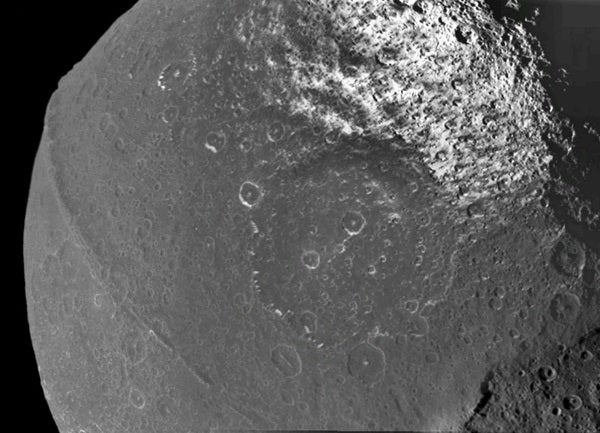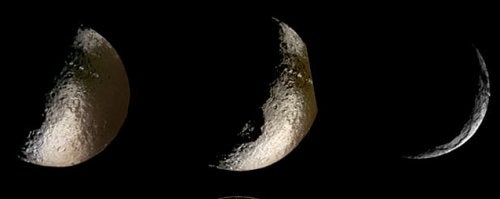hemisphere reflects lights like new-fallen snow. Cassini focused on the dark side. In this mosaic of uncalibrated imagery, an older impact basin can be seen surrounded by younger craters with bright rims and bullseye central peaks. A seam-like spine of mountains trails left.
On December 31, NASA’s Cassini spacecraft made its closest pass yet to one of Saturn’s smaller icy satellites when it flew by Iapetus. This flyby was Cassini’s closest of a small saturnian moon since its arrival around the ringed planet June 30.
The most remarkable feature seen in Cassini’s Iapetus images is a topographic ridge that coincides almost exactly with the satellite’s geographic equator. The ridge is conspicuous in the picture above as an approximately 12-mile wide (20 kilometer) band that extends from the western limb of the disk (left) almost to the terminator, the boundary between day and night on Iapetus (right).
The ridge peak rises at least 8 miles (13 km) above the surrounding terrain. Looking almost like the moon’s seam, the ridge runs approximately 800 miles (1,300 km) and, to within a couple of degrees, parallels the equator.
The ridge’s physical origin has yet to be explored. It isn’t yet clear whether the ridge is a compressional feature, like a mountain belt that has folded upward, or an extensional crack in the surface through which material from inside Iapetus erupted.
Iapetus is Saturn’s third-largest satellite, with a diameter of 890 miles (1,400 km). Cassini approached within 76,700 miles (123,400 km) for this, its first encounter with the moon. Another close flyby of Iapetus is scheduled for 2007. The last look at Iapetus was by NASA’s Voyager 1 and 2 spacecraft in 1980 and 1981, respectively.
The moon was discovered by French astronomer Jean-Dominique Cassini in 1672. It was Cassini, for whom the Cassini-Huygens mission is named, who correctly deduced that one side of Iapetus is dark, while the other is white. Iapetus’ leading hemisphere is one of the darkest surfaces in the solar system. By contrast, its trailing hemisphere is as white as freshly fallen snow. The question astronomers want to answer is: Did the dark material originate from an outside source, or was it created within Iapetus?”
A possible outside source for the moon’s dark material is Phoebe, another saturnian moon. Material may have been ejected from Phoebe and then drifted inward to fall on Iapetus. The dark material on Iapetus is redder than material on Phoebe, but some astronomers think the material may have undergone a chemical change after it left Phoebe.
The internal origin theory, on the other hand, has some possible observational evidence. Crater floors show a higher concentration of the dark material, implying something is filling the craters. Astronomers have proposed a model whereby methane erupts from Iapetus’ interior and then becomes darkened by the Sun’s ultraviolet radiation.
Cassini’s next satellite encounter is scheduled for January 14, 2005. The target will be Saturn’s largest moon, Titan.











